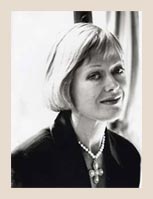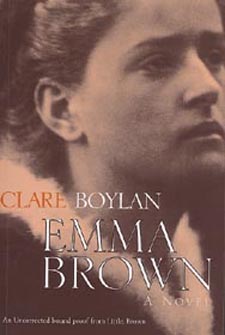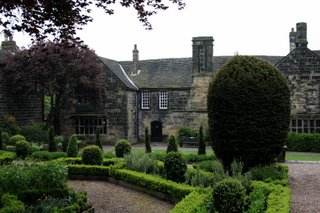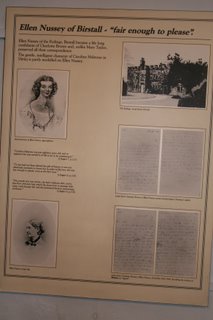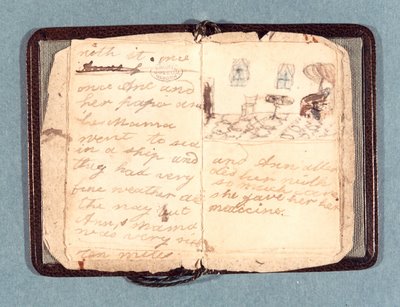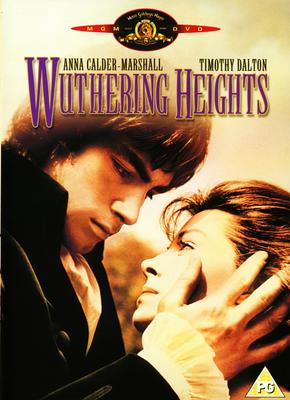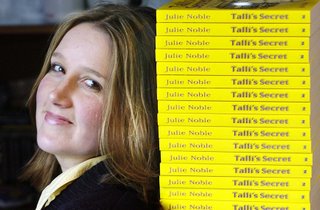Richard Wilcocks writes:
On Friday 19 May Kirklees Community History and Kirklees Tourism launched the Shirley Country Guide. To be strictly accurate, they relaunched it in a splendid new colour version, because it has appeared in a shorter form before.
Shirley Country is the name generally accepted by both the Brontë Society and Kirklees Metropolitan Council as the name for the area of West Yorkshire crossed by the River Spen and the manically busy M62 motorway which contains such havens of leafy tranquillity as the Red House in Gomersal, Oakwell Hall in Birstall and St Peter's Church in Hartshead, an area well known to Charlotte Brontë, Ellen Nussey, Mary Taylor and many of the real-life characters who appeared with fictional names in Shirley.
Published in 1849, the novel caused quite a sensation. The local literate, gossiping classes had only just discovered that the quiet parson's daughter from Haworth was secretly the famous Currer Bell, the author of Jane Eyre. Now they found themselves and their neighbours appearing in her latest work.
Charlotte knew the area well from her schooldays in Mirfield and was a frequent visitor. When Charlottë's parents were first married they lived in Hightown, and her father was minister at Hartshead at the time of the Luddite riots of 1812.
The guide features information, directions to and a map of fourteen places which Charlotte knew. Visitors are invited to create their own literary trail.
Some locations have actually disappeared - Rawfold's Mill, for example, which once held out against hundreds of armed and masked Luddites - most of them skilled workers intent on smashing up the new machinery inside which had taken away their livelihoods. It is now a corner of a modern industrial estate.
Oakwell Hall, on the other hand, is thriving in its hundred acres of idyllic parkland rolling down to the edge of the M62, an Elizabethan manor house which contains many of the features of Fieldhead, as described by Charlotte in Shirley, with a visitors' centre nearby geared to the needs of school parties.
The launch started here. Several dozen guests - including representatives of the Brontë Society - watched Charlotte (played by Tania Gillmartin) and Ellen (Bridgid Harbour) arrive by horse-drawn carriage, to be met by the Mayor of Kirklees, Councillor Margaret Fearnley. Joanne Catlow as Shirley Keeldar confronted Chris Yates as the Curate Mr Donne as part of a dramatised extract from the novel performed in the dark-panelled main hall inside.
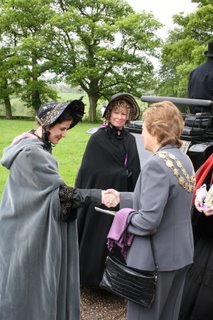
Charlotte and Ellen later travelled by horse-drawn carriage to Briarmains - Red House. The guests went by a more modern coach.

At Briarmains, Mary Taylor (Julie O'Connell) did the greeting, and snifters of madeira wine were available, to be consumed during the watching of more dramatisations: the three friends conversed, Ellen regaling the other two with a shocking story of bigamy involving a gentleman who secretly kept a lunatic wife in an upstairs room.
Then Robert Moore (John Bunker) walked through the front door - based on William Cartwright, whose mill at Rawfolds received the attention of the rioters. He talked with Hiram Yorke (Phil Knight) who was based on Mary's father Joshua Taylor.
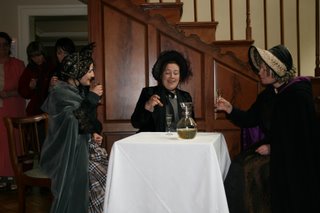
The guests boarded the coach after this for a tour of some of the sites included in the guide - down Spen Lane to St Mary's Church where Mary Taylor is buried, on to the Gomersal Lodge Hotel (formerly High Royd, Mary Taylor's home up to her death in 1893), past the site of Rawfold's Mill, on to Healds Hall, Liversedge (now a sumptuous hotel), past Ellen Nussey's early home Rydings (now situated next to a paint factory), past St Peter's Church in Birstall and back to Oakwell Hall.
Later, at the Gomersal Park Hotel, which is a greatly extended version of Ellen Nussey's Moor Lane House, some of the costumed characters welcomed guests to a literary lunch. The speaker was the well-known Yorkshire Television presenter Ian Clayton, who talked about language change in Yorkshire, his own background as a miner's son who went to grammar school and an occasion when he was shaking hands with the Archbishop of York when his mobile phone suddenly rang with the tune of 'Popeye the Sailor Man'. He read short extracts from several books including, of course, Shirley.
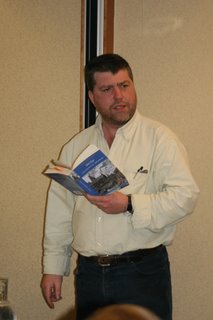
You can visit Kirklees Tourism by clicking on the link on the right. If you want a copy of the guide, contact Joanne Catlow at 01484 223803 (add +44, delete the initial 0 if you are not in the UK) or email her: joanne.catlow@kirklees.gov.uk
Say you heard about it from this blog.
Photocredits: Richard Wilcocks
On Friday 19 May Kirklees Community History and Kirklees Tourism launched the Shirley Country Guide. To be strictly accurate, they relaunched it in a splendid new colour version, because it has appeared in a shorter form before.
Shirley Country is the name generally accepted by both the Brontë Society and Kirklees Metropolitan Council as the name for the area of West Yorkshire crossed by the River Spen and the manically busy M62 motorway which contains such havens of leafy tranquillity as the Red House in Gomersal, Oakwell Hall in Birstall and St Peter's Church in Hartshead, an area well known to Charlotte Brontë, Ellen Nussey, Mary Taylor and many of the real-life characters who appeared with fictional names in Shirley.
Published in 1849, the novel caused quite a sensation. The local literate, gossiping classes had only just discovered that the quiet parson's daughter from Haworth was secretly the famous Currer Bell, the author of Jane Eyre. Now they found themselves and their neighbours appearing in her latest work.
Charlotte knew the area well from her schooldays in Mirfield and was a frequent visitor. When Charlottë's parents were first married they lived in Hightown, and her father was minister at Hartshead at the time of the Luddite riots of 1812.
The guide features information, directions to and a map of fourteen places which Charlotte knew. Visitors are invited to create their own literary trail.
Some locations have actually disappeared - Rawfold's Mill, for example, which once held out against hundreds of armed and masked Luddites - most of them skilled workers intent on smashing up the new machinery inside which had taken away their livelihoods. It is now a corner of a modern industrial estate.
Oakwell Hall, on the other hand, is thriving in its hundred acres of idyllic parkland rolling down to the edge of the M62, an Elizabethan manor house which contains many of the features of Fieldhead, as described by Charlotte in Shirley, with a visitors' centre nearby geared to the needs of school parties.
The launch started here. Several dozen guests - including representatives of the Brontë Society - watched Charlotte (played by Tania Gillmartin) and Ellen (Bridgid Harbour) arrive by horse-drawn carriage, to be met by the Mayor of Kirklees, Councillor Margaret Fearnley. Joanne Catlow as Shirley Keeldar confronted Chris Yates as the Curate Mr Donne as part of a dramatised extract from the novel performed in the dark-panelled main hall inside.

Charlotte and Ellen later travelled by horse-drawn carriage to Briarmains - Red House. The guests went by a more modern coach.

At Briarmains, Mary Taylor (Julie O'Connell) did the greeting, and snifters of madeira wine were available, to be consumed during the watching of more dramatisations: the three friends conversed, Ellen regaling the other two with a shocking story of bigamy involving a gentleman who secretly kept a lunatic wife in an upstairs room.
Then Robert Moore (John Bunker) walked through the front door - based on William Cartwright, whose mill at Rawfolds received the attention of the rioters. He talked with Hiram Yorke (Phil Knight) who was based on Mary's father Joshua Taylor.

The guests boarded the coach after this for a tour of some of the sites included in the guide - down Spen Lane to St Mary's Church where Mary Taylor is buried, on to the Gomersal Lodge Hotel (formerly High Royd, Mary Taylor's home up to her death in 1893), past the site of Rawfold's Mill, on to Healds Hall, Liversedge (now a sumptuous hotel), past Ellen Nussey's early home Rydings (now situated next to a paint factory), past St Peter's Church in Birstall and back to Oakwell Hall.
Later, at the Gomersal Park Hotel, which is a greatly extended version of Ellen Nussey's Moor Lane House, some of the costumed characters welcomed guests to a literary lunch. The speaker was the well-known Yorkshire Television presenter Ian Clayton, who talked about language change in Yorkshire, his own background as a miner's son who went to grammar school and an occasion when he was shaking hands with the Archbishop of York when his mobile phone suddenly rang with the tune of 'Popeye the Sailor Man'. He read short extracts from several books including, of course, Shirley.

You can visit Kirklees Tourism by clicking on the link on the right. If you want a copy of the guide, contact Joanne Catlow at 01484 223803 (add +44, delete the initial 0 if you are not in the UK) or email her: joanne.catlow@kirklees.gov.uk
Say you heard about it from this blog.
Photocredits: Richard Wilcocks
